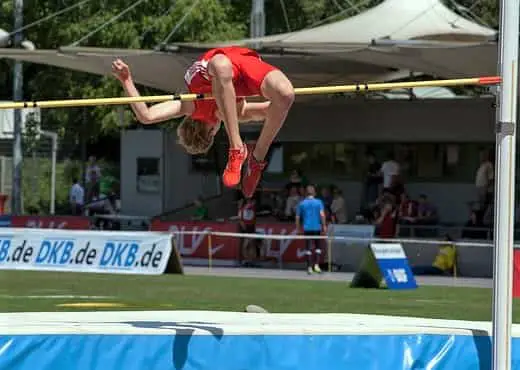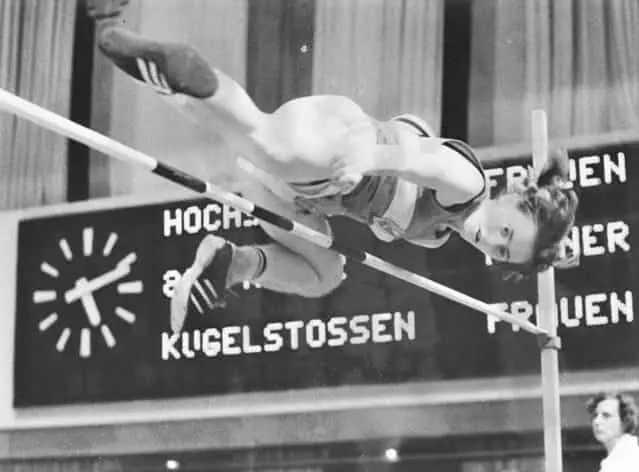Is the world record in high-jump of 2,45 meters set by Javier Sotomayor in 1993, the highest a human can jump… Ever?
How high can a human jump?
If everything is perfectly optimal, how high a jump is a human body able to perform? When is the world record going to be absolute, and no one will ever break it?
The human limit
The human body is a fantastic thing, an incredibly strong and endurable machine. It goes on and on for almost a hundred years, and it can be modeled and trained to perform the most unbelievable tasks. In sports, we see the most astonishing records every year and we watch in awe when the athletes seem to defy nature itself.
Track and Fields is where the most interesting records are noted. Who is the fastest runner? Who is the longest/highest jumper? And who is the longest thrower?
Track and Field
From the origins in ancient Greek, the art of running, jumping, and throwing was more or less forgotten in middle age Europe. For more than a thousand years, just as most other sports, athletics was not widely recognized. However, that changed when the modern Olympic games started in 1896. Suddenly the old war-training techniques became high fashion and from there a constant struggle to perform better and break the current record started. That path continues today with ever more refined measures and computerized analytics.
The records
Any performance depends on a variety of factors. And some of these are independent of the athlete or his capabilities. Let’s make a list of things that have an impact on an execution, and the result of it.
 The physical strength and stamina of the athlete.
The physical strength and stamina of the athlete.- The technique acquired by the athlete, for that particular discipline.
- The technical aspects of material and equipment.
- The psychological stability and focus of the athlete.
- Other circumstances such as meteorological factors, spectators, height over sea level, etc.
As we are going to focus on high-jump, let’s start out with the highest jumper ever in the world, so far.
Javier Sotomayor
This extraordinary athlete holds the record in high-jump. On the sunny Friday in Salamanca, Spain, on July 23, 1993, the Cuban athlete sailed over 2,45 meters (8.054 feet). He already held the world record twice with 2,43 and 2,44. But now he became totally unbeatable. He is the only man who’s jumped over 8 feet. And he holds one of the oldest records in track and field.
And this is the first clue to understanding how high a human can jump. Running records tend to be newer, suggesting they are easier to break than throwing- and jumping records. But let’s check the list point by point.
The physical strength and stamina of the athlete.
Without being too offensive I think it is common knowledge that the use of doping was much more widespread in the past than it is today. Even if we put the obnoxious GDR state-based systematic doping program aside, doping was much more available, and less illegitimate, all over the world 50 years ago. The World Anti-Doping Agency was formed in 1999 to prevent athletes in any field from being able to increase their performance by the use of drugs. Nowadays, the agency can test any athlete at any meeting, or away from the meeting, during training, or even at the athlete’s home, unannounced.

Courtesy of Deutsches Bundesarchiv.
We now have some very old records that sometimes are regarded as unbeatable. Many of which were surely achieved with the help of unallowed substances. As it is becoming increasingly difficult to use doping and get away with it, these results will probably remain for a very long time.
It is not controversial to assume that the physical ability of a top athlete in the near future will not exceed that of the best performers of the 80s and the 90s. Having said this, it’s obvious that the training is getting better with time. We know more about how to maximize strength and stamina, and how training should be carried out. Maybe knowledge can compensate for the lack of performance-enhancing drugs.
Javier Sotomayor was tested positive for doping twice. In 1999 for Cocaine and in 2001 for Nandrolone, an anabolic steroid. He was disqualified in his last World Championship in 2001.
The technique acquired by the athlete, for that particular discipline.
In 1968, at the Olympic Summer Games in Mexico City, a young American by the name of Richard Douglas Fosbury made a whole world choke on their evening sandwich. Not only did he have the most ridiculous high jump technique they had ever seen, but he actually won the whole competition with a personal record of 2,24 meters.
These things happen very rarely, but when they do, they change the sport forever.
- It happened in triple-jump in 1995 when Jonathan Edwards, GB, won the World Championship. He broke the world record twice in the same meeting.
- It happened when Jan Železný, Czech Republic, in 1992 at the Olympic Summer Games in Barcelona changed the way the javelin was thrown.
But the Fosbury-Flop changed high jump from one day to another. And from 1978 and onwards, all world records have been set with the Fosbury Flop. The only such revolutionary change in techniques I can come up with is when Jan Boklöv, Sweden, won the World Cup in Ski jumping, using the V-jump in 1989.
The Fosbury Flop
The curved approach, when done correctly, gives a high horizontal velocity. A part of that energy is then used by the jumping leg to create a vertical force. The curve should create a rotation that forces the athlete over the bar without him having to think about that. The horizontal movement through the air should come automatically. The jump-leg converts the horizontal speed to vertical movement.
Vladimir Yashchenko – The last world record holder jumping with the straddle technique
More so, the curved approach allows the athlete to be in a low position at the end of the run-up which increases the vertical push. It also makes the athlete lean away from the bar at the time that the takeoff foot is planted, which generates angular momentum during the takeoff without having to lean into the bar by the end of the takeoff.
While in flight, the athlete progressively arch shoulders, back, and legs, keeping as much of the body as possible below the bar. This is another unique feature. It is possible for the Center of Mass to pass under the bar while the curved body is over the bar, one piece at a time.
The Fosbury Flop is a perfect technique for high jump. Even with modern computer-based analytisìcs, it is impossible to calculate a radically different way to perform a high jump that is more effective. What scientists and coaches do and have done for the last centuries, is to make it even more perfect by minimizing the variables. They analyze speed, angle, and approach-curve to get as close as possible to the perfect jump.
But it is reasonable to imagine that the Fosbury Flop will never be surpassed by some other jump style. How high a human can jump, will not depend on some completely new variant but if the very small margins of errors in the Fosbury Flop can be perfectioned.
The technical aspects of material and equipment.

A few things to consider:
- High-jump doesn’t have any additional equipment like a javelin, a discus, or a pole. The improvement can only be applied to personal shoes and clothes, and the track surface.
- The importance of a soft landing space has been crucial to the development of new techniques. The straddle technique became possible from the fifties, as more stadiums abandoned the sand pitch for the softer landing mats. A smooth landing was crucial for the development of the Fosbury flop. In a sand pitch, one would likely break one’s neck with the Flop.
- Personal equipment has a relatively small impact on the jump. Compared to running and long jump, the high-jumper typically uses fewer strides (very much fewer than long-distance running), and the speed is lower. It is true however that a better surface could improve the bounce of the jump-leg.
The conclusion must be that improvements in the material have a smaller effect on high jump than on running and long jump. And compared to pole vault it’s definitely so.
The psychological stability and focus of the athlete.
Somewhere around 1980, sports psychologists started to show up around the training facilities. The idea that psychological preparation is almost as important as the physical one, opened a whole new world of opportunities. After some time, everybody had their own psychological experts. Hypnosis and small internal happy-rooms became everyday, mainstream knowledge.

Some of the instructions were closely connected to the physical training… Such as techniques to avoid conflicting muscle activity. While other aspects of the coaching included increasing the winner-instinct and leveling the results. To get better you can either increase your best performance or increase your worst. If you have jumped 2,45 once but often only reach 2,20, then raising the lower performance to, let’s say, 2,30 could mean winning much more often.
All these techniques made a huge difference when they started out. But now, after 40 years, we have a very good idea of how to blend psychological training with the physical. And there isn’t all that much to improve from it anymore, from a record point of view.
Other circumstances.
- Wind. In high-jump the wind has a much lesser impact than on, let’s say, long-jump. High-jump consequently doesn’t have any limits for wind assistance.
- Other weather phenomena. These can only worsen compared to the conditions at world record occasions.
- Height over sea level. When Dick Fosbury won in Mexico City, the height was 2200 meters AMSL. Another famous record was Bob Beamon’s fantastic 8,90 meters in the long-jump final. That record lived on for 23 years and still is the Olympic record today, after 52 years. The high altitude was definitely a contributing factor. Sotomayor’s world record of 2,45 was set at 800 meters AMSL
So, how high can a human jump?
Let’s check the development of the winners in the major events:
Olympics Gold Medals Men:
- 1948 1,98
- 1952 2,04
- 1956 2,12 straddle
- 1960 2,16 straddle
- 1964 2,18 straddle
- 1968 2,24 Fosbury flop
- 1972 2,23 straddle
- 1976 2,25 Fosbury flop
- 1980 2,36 Fosbury flop
- 1984 2,35
- 1988 2,38
- 1992 2,34 – five athletes on the same level
- 1996 2,39
- 2000 2,35
- 2004 2,36
- 2008 2,36
- 2012 2,33
- 2016 2,38
World Championship Gold Medals Men:
- 1983 2,32
- 1987 2,38
- 1991 2,38
- 1993 2,40
- 1995 2,37
- 1997 2,37
- 1999 2,37
- 2001 2,36
- 2003 2,35
- 2005 2,32
- 2007 2,35
- 2009 2,32
- 2011 2,35
- 2013 2,41
- 2015 2,34
- 2017 2,35
- 2019 2,37
How often is a new World record set?
After WW2 the High-jump world record for men was broken in
- 1953
- 1956
- 1957
- 1960 (3 times)
- 1961 (3 times)
- 1962 (twice)
- 1963
- 1971
- 1973
- 1976 (twice)
- 1977
- 1978 (the last record with straddle technique)
- 1980 (3 times)
- 1983 (twice)
- 1984
- 1985 (twice)
- 1987
- 1988
- 1989
- 1993.
After 1993, the world record hasn’t been broken. That’s 28 years.

It is very obvious that the heights more or less stopped develop after the 1980s. In the 80s the world record went from 2.35 to 2.44. But then the progression died, like a punctured balloon.
I have been focusing on Men’s high-jump simply because they jump higher. The question is: How high can a human jump, and men jump higher in absolute numbers. However, all that’s been said here is applicable to Women’s high-jump as well. Stefka Kostadinova, Bulgaria still holds the world record with 2.09 meters. And that is even older than that of Sotomayor… Dating from 1987. The same plateau as with men can be observed in women’s high-jump. After the 1980s, improvement stopped.
Conclusion
Yes, I know, we can’t look into the future. We cannot be sure about what high-jumping will be like in a hundred years. But so far, I think the tendency is quite obvious. To me, it is very clear that the world record in high-jump will remain as it is for a considerable time. That Friday in Salamanca in 1993 was magical, and maybe just maybe, it will remain magical forever.
I will list a few arguments.
- It is indisputable that improvements in material and equipment have a relatively small impact on high-jump. The only jump- or throw world record set after 2000 is in pole vault. And pole vault depends heavily on the equipment, i.e. the pole.
- The technique used to jump, the Fosbury Flop, is very close to perfection. It is highly unlikely that some new, yet undiscovered, way to perform the jump could come forth.
- Physical strength is penalized by rigorous controls by the World Anti-Doping Agency. The glorious days of doping that we experienced in the seventies and the eighties are fortunately over.
- The winning strike at major competitions confirms a plateau in improved results from the beginning of the 1980s. The men’s world record also abruptly plateaued in 1993.
It’s difficult to say, but if 2.45 meters isn’t an absolute limit, then it’s darn close. Everything points to stabilized high-jump results. And without performance-enhancing pills, there just isn’t enough margins to beat it… Or even reach it. I think Sotomayor’s 2.45, will live on for a very long time.
sources
- Jesus Dapena – The evolution of high jumping technique
- Shawn Rembecky / The physics of the high jump
- Jesus Dapena / Biomechanics in sport – High Jump
- Die Zeit / Doping – Poisoned by East Germany
- Scence Direct / Analytical aspects in doping control: Challenges and perspectives
- Olympic.org
- Wikipedia / high jump etc.
- Topend Sports / World Best Vertical Jump Scores
- Carolina Performance / Where it all began- The History of sport psychology research
… I throw in a few other jumping records here… just for fun.
Standing high jump. Former a part of the Olympic program but was abandoned after the 1912 Olympics.
World record – Rune Almèn (Sweden) 1,90 meters
THE VIDEO IS NOT OF RUNE ALME’N. Sorry, but I don’t have footage of him.
Standing jump (box jump). You have to jump up and place your feet on a horizontal plan, and remain there without falling off.
Guinness world record – Brett Williams (USA) 5 feet and 5.0 inches (1.651 meters)
THE VIDEO IS OF THE PREVIOUS RECORD BY EVEN UNGAR (Canada). Sorry, but I don’t have footage of Brett Williams either.
How high do the basket players jump?
Wilt Chamberlain is credited with the highest jump ever of 48 inches. This is how high he should have jumped his whole body, read the head, from a running approach. When slamming the hand up on a board the jump is lower. This record is sometimes contested as it’s old and practically based on anecdotal evidence. Wilt Chamberlain was a supernatural jumper though, no doubt about that.https://youtu.be/ZmBc8NX_oL8
… And last a video from Kenya. Check out these guys and my conclusion about the impossibility to break the 2.45 meters world record, suddenly seems very uncertain. The human body can do amazing things…